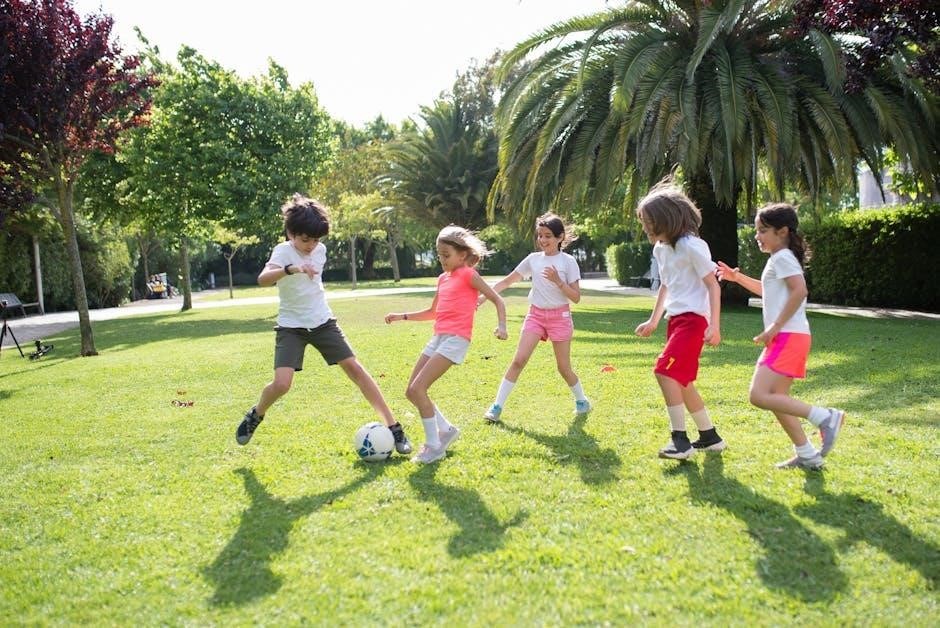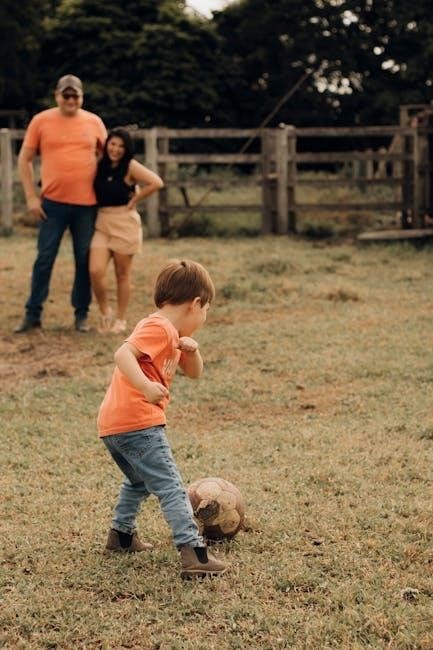Fun Budgeting Activities PDF: An Engaging Approach to Financial Literacy
Discover how interactive games, real-life simulations, and hands-on worksheets make learning about money management exciting for students of all ages. Engage your audience with practical, fun tools!
Engaging students in financial literacy through fun budgeting activities is essential for developing practical life skills. These activities transform complex concepts into interactive experiences, making learning enjoyable and relatable. From games like The Price is Right to hands-on worksheet exercises, these methods cater to various learning styles. They encourage critical thinking, decision-making, and teamwork while teaching the importance of saving, spending, and prioritizing. Suitable for all age groups, these activities adapt to different educational settings, ensuring that financial literacy becomes accessible and entertaining. By incorporating real-life scenarios and creative challenges, fun budgeting activities empower individuals to manage their finances confidently and responsibly.

Budgeting Games for High School Students
Engage teens with interactive budgeting games like The Price is Right and board game-style activities. These tools make financial literacy fun, teaching practical saving and spending skills effectively.
2.1. Play The Price is Right
Transform budgeting into an exciting game by adapting The Price is Right concept. Students guess prices of everyday items, fostering awareness of real-world costs. After revealing prices, discuss how to allocate a fictional budget, making financial decisions engaging and relatable. This activity not only teaches pricing awareness but also encourages critical thinking about spending priorities. It’s a fun, competitive way to introduce budgeting basics, helping teens understand the value of money and the impact of their purchasing choices. The interactive nature of the game ensures active participation and a memorable learning experience.
2.2. Turn Budgeting into a Board Game
Create a custom board game where players navigate life stages, earning paychecks and facing unexpected expenses. This hands-on activity simulates real-life financial decisions, teaching budgeting fundamentals in a fun, interactive way. Players move through the game, managing income and expenses, while learning to prioritize spending. The game can be tailored to include scenarios like saving for college or planning a vacation. By incorporating props, scenario cards, and budget charts, students engage deeply with financial concepts. This approach transforms budgeting into a collaborative and competitive experience, making it easier for teens to grasp complex financial ideas while enjoying the process. It’s an innovative way to build practical life skills through play.
2.3. Play with the Big Picture
Encourage students to think broadly by assigning them a total budget for a large project, such as planning a trip or organizing an event. This activity helps them understand how to allocate funds across different categories like transportation, food, and entertainment. By visualizing the entire budget, they learn to prioritize spending and make trade-offs. Introduce challenges like unexpected expenses to simulate real-life scenarios. Using budget charts and graphs, students can track their spending and adjust allocations. This holistic approach teaches them to manage finances effectively while maintaining a balanced perspective. It’s a powerful way to prepare them for future financial responsibilities. Hands-on and engaging, this activity fosters critical thinking and problem-solving skills.

Hands-On Budgeting Activities for Teens
Engage teens with interactive budgeting tasks that teach financial management through practical exercises. Use worksheets, shopping simulations, and savings challenges to build essential money management skills.
3.1. Use Budget-Planning Worksheets
Budget-planning worksheets are an effective way to guide teens in managing finances. These tools help track income, expenses, and savings goals, teaching practical money management. By allocating funds into categories like education, entertainment, and emergencies, teens gain clarity on spending habits. Worksheets also encourage long-term planning, such as saving for college or a car. Interactive designs, including visual charts and tables, make the process engaging. This hands-on approach helps teens understand the importance of prioritizing needs over wants. Regular use of these worksheets fosters financial discipline and prepares teens for real-life budgeting challenges. It’s a simple yet impactful way to build essential life skills.

3.2. Create a Buying Plan
Creating a buying plan is a practical and engaging activity that teaches teens to make intentional purchasing decisions. Start by identifying needs versus wants and setting a budget. Teens can practice comparing prices, researching deals, and prioritizing essential items. This activity helps develop critical thinking and financial decision-making skills. Encourage teens to create a shopping list and stick to it, ensuring they stay within budget. For added fun, incorporate real-life scenarios, like planning a back-to-school shopping trip or buying supplies for a event. This hands-on approach turns budgeting into a relatable and achievable task, preparing teens for independent financial management.
3.3. Practice Grocery Shopping
Transform grocery shopping into an interactive learning experience. Assign teens a budget and challenge them to purchase essential items within it. Use real-life scenarios, such as planning meals for a week or hosting a family dinner. Incorporate coupons, sales, and unit prices to teach cost-effective shopping. For added engagement, create a scavenger hunt where teens find the best deals. Discuss the importance of comparing brands and avoiding impulse buys. This activity not only teaches budgeting but also practical life skills, making financial literacy both fun and applicable to everyday life. It’s an excellent way to bridge theory with real-world application, ensuring lasting understanding.
3.4. Build a Savings First-Aid Kit
Teach teens the importance of emergency savings with a hands-on activity. Create a “Savings First-Aid Kit” where they allocate a portion of their budget to unexpected expenses. Use budgeting worksheets to track progress and discuss the 50/30/20 rule for saving. Encourage setting aside 10-20% of their income for emergencies. This activity helps teens understand the value of prioritizing savings and preparing for the future. Make it fun by adding visual elements, like a savings thermometer, to track their goals. This practical approach teaches financial discipline and ensures they’re ready for life’s unexpected challenges, fostering long-term financial stability and confidence.

Creative Ways to Teach Kids About Budgeting
Engage children with interactive games, hands-on activities, and real-life scenarios that simplify money management. Make learning fun with visual tools and relatable examples that spark their interest in finance.
4.1. The Jar System
The Jar System is a simple, hands-on method to teach kids about money management. Divide money into jars labeled for saving, spending, and giving. This visual approach helps children understand budget basics and prioritization. By categorizing funds, they learn to allocate resources wisely, fostering a clear understanding of needs versus wants. The jars make budgeting interactive and fun, allowing kids to see their money grow in each category. This system is adaptable for different ages, making it an effective tool for early financial literacy. It encourages responsibility and helps build a strong foundation for managing money thoughtfully. The Jar System is a timeless, engaging way to introduce budgeting concepts to young learners.

4.2. Needs vs. Wants Sorting Experience
This activity helps kids distinguish between essential needs and discretionary wants. Using cards or visuals, children sort items into two categories, sparking discussions about priorities. It’s a fun way to teach financial decision-making. By understanding the difference, kids learn to allocate resources wisely, focusing on what’s truly important. This exercise promotes critical thinking and responsible spending habits. The sorting experience is interactive and engaging, making complex concepts accessible. It’s a valuable tool for instilling smart money management from a young age, helping children make thoughtful choices about how to use their money effectively; This activity lays the groundwork for a lifetime of financial awareness and responsibility.
4.3. Lemonade Tycoon
Lemonade Tycoon is a fun and educational activity that teaches kids the basics of entrepreneurship and budgeting. By running their own virtual lemonade stand, participants learn to manage expenses, set prices, and aim for profit goals. This interactive game simulates real-world financial challenges, encouraging strategic thinking and decision-making. Players must balance costs like ingredients and supplies with revenue from sales, adapting to changing conditions. The goal is to maximize profits while understanding the importance of budgeting and saving. This engaging activity makes learning about money management both enjoyable and relatable, helping kids develop essential life skills in a hands-on way. It’s a refreshing way to teach financial literacy!

Real-Life Budgeting Scenarios
Engage students with interactive, realistic budgeting challenges, such as planning a city trip or managing event expenses, to teach practical financial literacy in a fun, relatable way.
5.1. Budgeting for a Trip to the City
Plan a city adventure with a budget! Students allocate funds for transportation, meals, attractions, and souvenirs. Create a realistic budget of $800, considering event tickets, food, and lodging. Use interactive worksheets or apps to track spending and make adjustments. Encourage students to research affordable options, such as public transport or free attractions. This activity teaches practical financial decision-making while exploring real-world scenarios. Make it engaging by adding a scavenger hunt or challenge to find the best deals. Help students understand the value of prioritizing expenses and sticking to a budget for a fun, memorable experience.
5.2. Planning a Fun Event
Transform budgeting into excitement by planning a fun event! Students learn to allocate funds for venue rentals, decorations, food, and entertainment. Assign a total budget and challenge them to prioritize expenses. Use scenario cards or worksheets to track spending. Discuss the importance of balancing costs and sticking to the budget. Encourage creativity by brainstorming low-cost alternatives. This activity helps students understand financial decision-making in a real-world context. Make it interactive by incorporating a budget chart or hosting a mock event planning session. Teach the value of money management while fostering teamwork and problem-solving skills. A practical way to make budgeting both educational and enjoyable!
Engaging budgeting activities create a fun, interactive way to teach financial literacy. By turning budgeting into games, hands-on exercises, and real-life scenarios, students develop essential money management skills. These activities foster critical thinking, responsibility, and a deeper understanding of financial decisions. From high school students to younger kids, interactive tools make learning about budgets enjoyable and relatable. The key is to provide practical experiences that prepare individuals for real-world challenges. By incorporating creativity and collaboration, budgeting becomes a positive and empowering process. Start early, make it fun, and watch financial confidence grow. These activities are not just educational—they’re a foundation for a lifetime of smart money habits.
